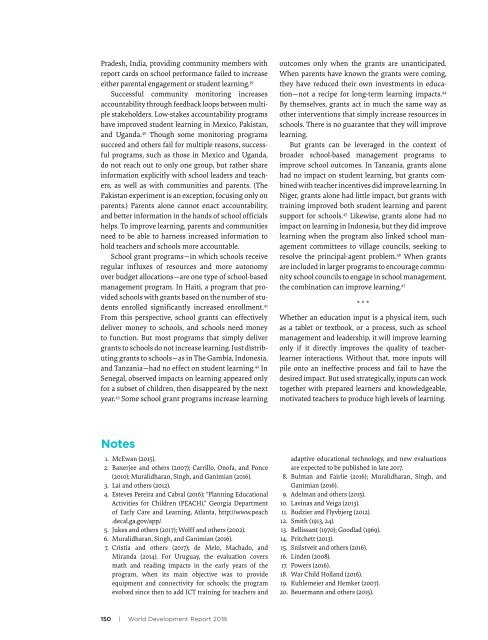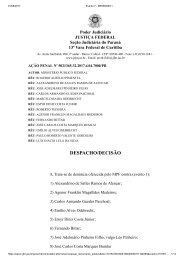Brasil só deve dominar Leitura em 260 anos, aponta estudo do Banco Mundial Relatorio Banco Mundial _Learning
You also want an ePaper? Increase the reach of your titles
YUMPU automatically turns print PDFs into web optimized ePapers that Google loves.
Pradesh, India, providing community m<strong>em</strong>bers with<br />
report cards on school performance failed to increase<br />
either parental engag<strong>em</strong>ent or student learning. 39<br />
Successful community monitoring increases<br />
accountability through feedback loops between multiple<br />
stakeholders. Low-stakes accountability programs<br />
have improved student learning in Mexico, Pakistan,<br />
and Uganda. 40 Though some monitoring programs<br />
succeed and others fail for multiple reasons, successful<br />
programs, such as those in Mexico and Uganda,<br />
<strong>do</strong> not reach out to only one group, but rather share<br />
information explicitly with school leaders and teachers,<br />
as well as with communities and parents. (The<br />
Pakistan experiment is an exception, focusing only on<br />
parents.) Parents alone cannot enact accountability,<br />
and better information in the hands of school officials<br />
helps. To improve learning, parents and communities<br />
need to be able to harness increased information to<br />
hold teachers and schools more accountable.<br />
School grant programs—in which schools receive<br />
regular influxes of resources and more autonomy<br />
over budget allocations—are one type of school-based<br />
manag<strong>em</strong>ent program. In Haiti, a program that provided<br />
schools with grants based on the number of students<br />
enrolled significantly increased enrollment. 41<br />
From this perspective, school grants can effectively<br />
deliver money to schools, and schools need money<br />
to function. But most programs that simply deliver<br />
grants to schools <strong>do</strong> not increase learning. Just distributing<br />
grants to schools—as in The Gambia, In<strong>do</strong>nesia,<br />
and Tanzania—had no effect on student learning. 42 In<br />
Senegal, observed impacts on learning appeared only<br />
for a subset of children, then disappeared by the next<br />
year. 43 Some school grant programs increase learning<br />
outcomes only when the grants are unanticipated.<br />
When parents have known the grants were coming,<br />
they have reduced their own investments in education—not<br />
a recipe for long-term learning impacts. 44<br />
By th<strong>em</strong>selves, grants act in much the same way as<br />
other interventions that simply increase resources in<br />
schools. There is no guarantee that they will improve<br />
learning.<br />
But grants can be leveraged in the context of<br />
broader school-based manag<strong>em</strong>ent programs to<br />
improve school outcomes. In Tanzania, grants alone<br />
had no impact on student learning, but grants combined<br />
with teacher incentives did improve learning. In<br />
Niger, grants alone had little impact, but grants with<br />
training improved both student learning and parent<br />
support for schools. 45 Likewise, grants alone had no<br />
impact on learning in In<strong>do</strong>nesia, but they did improve<br />
learning when the program also linked school manag<strong>em</strong>ent<br />
committees to village councils, seeking to<br />
resolve the principal-agent probl<strong>em</strong>. 46 When grants<br />
are included in larger programs to encourage community<br />
school councils to engage in school manag<strong>em</strong>ent,<br />
the combination can improve learning. 47<br />
* * *<br />
Whether an education input is a physical it<strong>em</strong>, such<br />
as a tablet or textbook, or a process, such as school<br />
manag<strong>em</strong>ent and leadership, it will improve learning<br />
only if it directly improves the quality of teacherlearner<br />
interactions. Without that, more inputs will<br />
pile onto an ineffective process and fail to have the<br />
desired impact. But used strategically, inputs can work<br />
together with prepared learners and knowledgeable,<br />
motivated teachers to produce high levels of learning.<br />
Notes<br />
1. McEwan (2015).<br />
2. Banerjee and others (2007); Carrillo, Onofa, and Ponce<br />
(2010); Muralidharan, Singh, and Ganimian (2016).<br />
3. Lai and others (2012).<br />
4. Esteves Pereira and Cabral (2016); “Planning Educational<br />
Activities for Children (PEACH),” Georgia Department<br />
of Early Care and <strong>Learning</strong>, Atlanta, http://www.peach<br />
.decal.ga.gov/app/.<br />
5. Jukes and others (2017); Wolff and others (2002).<br />
6. Muralidharan, Singh, and Ganimian (2016).<br />
7. Cristia and others (2017); de Melo, Macha<strong>do</strong>, and<br />
Miranda (2014). For Uruguay, the evaluation covers<br />
math and reading impacts in the early years of the<br />
program, when its main objective was to provide<br />
equipment and connectivity for schools; the program<br />
evolved since then to add ICT training for teachers and<br />
adaptive educational technology, and new evaluations<br />
are expected to be published in late 2017.<br />
8. Bulman and Fairlie (2016); Muralidharan, Singh, and<br />
Ganimian (2016).<br />
9. Adelman and others (2015).<br />
10. Lavinas and Veiga (2013).<br />
11. Budzier and Flyvbjerg (2012).<br />
12. Smith (1913, 24).<br />
13. Bellissant (1970); Goodlad (1969).<br />
14. Pritchett (2013).<br />
15. Snilstveit and others (2016).<br />
16. Linden (2008).<br />
17. Powers (2016).<br />
18. War Child Holland (2016).<br />
19. Kuhl<strong>em</strong>eier and H<strong>em</strong>ker (2007).<br />
20. Beuermann and others (2015).<br />
150 | World Development Report 2018








